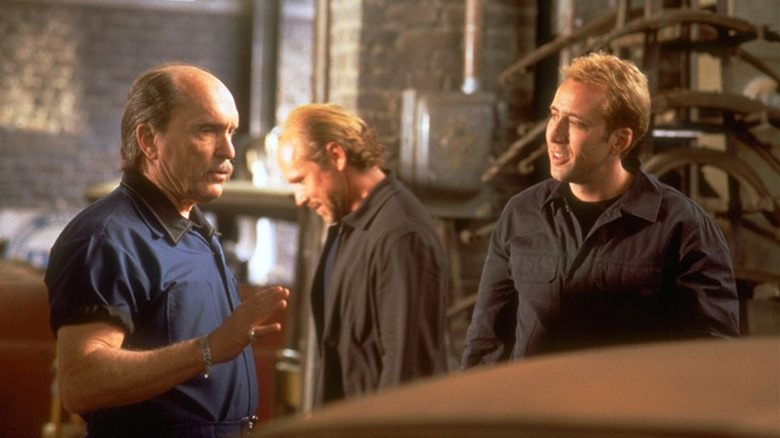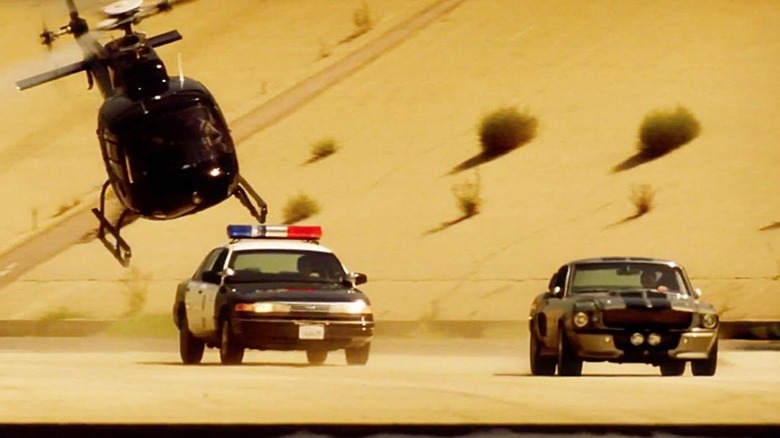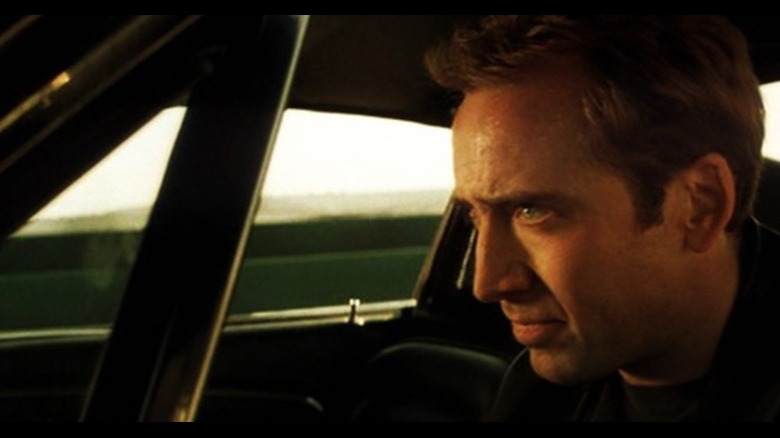Nicolas Cage Really Got Behind The Wheel For Gone In 60 Seconds
The car chase sequence carries an almost sacred significance across the action film genre. A jaw-dropping game of vehicular cat-and-mouse can do wonders for any movie. Just ask "Fast & Furious," which has built an entire cinematic universe around its characters using cars the way the MCU's superheroes use their powers. Right now the one burned into many people's minds comes from director Matt Reeves' "The Batman" and the terrifyingly spectacular chase between Robert Pattinson's caped-crusader and Colin Farrell's Penguin.
But any self-respecting film that attempts a car chase understands the adrenaline-fueling spectacle such scenes can bring. Although it doesn't always matter who is behind the wheel, be it a spy, detective, getaway driver, or a post-apocalyptic wasteland wanderer, it is important to the integrity of the chase that audiences can see the driver. This can be a problem when an actor with no stunt driving experience needs to be the one steering the car. But that wasn't the case for "Gone in 60 Seconds" when actor Nicolas Cage played a retired car thief pulled back into the game when his brother bungles a job for a merciless crime boss.
Cage ended up being a natural stunt driver
The plot of "Gone in 60 Seconds" might appear simple on paper, but the devil is in the details. The film follows Nicolas Cage's Randall "Memphis" Raines and his crew as they attempt the monumental and seemingly impossible task of stealing 50 cars in one night. But for all the grand theft autos that occur in the film, it all comes down to the final chase over the heavily foreshadowed theft of Raines' white-whale: a '60s Shelby GT500 lovingly named "Eleanor." During a WIRED segment Cage said:
"I did do my own stunts in that. I did go to a high-performance driving school, and I was working with Johnny Martin on that. And we were doing the 360s and the donuts and the whole kit and caboodle."
There's a reason "Gone in 60 Seconds" won in the category for Best Driving at the Taurus World Stunt Awards in 2001. Of course, Cage took the opportunity to learn from the best, and clearly, it paid off. Here's a refresher if you don't remember the full Eleanor pursuit scenes, which clock just under five minutes when only counting shots of the driving. High-octane is really the only way to describe it, and even when it gets a little ridiculous — like when the high-pressure tank is flailing around smashing cop cars or Raines takes that wild jump on the Gerald Desmond Bridge — the scene is grounded in the fact that we see Cage driving the whole time. This in itself was a crucial and strict priority for director Dominic Sena.
Audiences needed to believe Cage was really driving
Behind-the-scenes interviews reveal the extent of not just Cage's commitment, but that of the entire cast and crew in making the chases believable. For Dominic Sena that meant making sure his actors, which included Angelina Jolie, Giovanni Ribisi, and Delroy Lindo, got similarly intensive training as Cage. Sena believed there's nothing more damaging to a chase than an audience not believing the actor is actually driving:
"That really pulls you out of the movie, when you can't see the star of the movie driving the damn car. And I just knew that Nic was a car buff. I thought that was a plus, because I suspected he could really drive a car. ... Sure enough he got behind the wheel of that car and scared the s*** out of everybody. That's him doing all these 180s and 360s and driving down the riverbed. He does most of his own stunts so it just makes all the difference in the world, to see him behind the wheel, see the buildings going by and see cars swerving behind him as opposed to the sort of green screen thing."
What makes Cage and anyone else driving a stunt vehicle that much more impressive is how much rigging the cars have. The Shelby GT is covered in cameras to the point that it looks like one of the heavily modified autos in "Mad Max: Fury Road." Even with all the training, as stunt coordinator Chuck Picerni Jr. explains in the video, "it takes some of the danger out of play," but obviously not all of it, which Sena recalls elicited both anger and nervousness from studio executives and lawyers when they found out Cage was doing most of his stunts, though the only real filming losses were a couple of BMWs worth $60,000 a piece. As for Cage and the rest of the cast-turned-stunt drivers, "Gone in 60 Seconds" is all the better for the literal extra miles they went learning how to put the pedal to the metal for the film.


